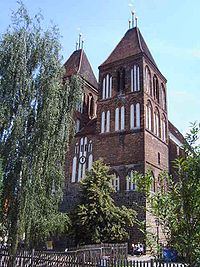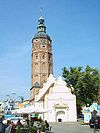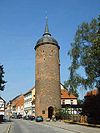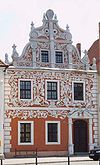
Luckau
Encyclopedia
Luckau is a city in the district of Dahme-Spreewald
in the federal state of Brandenburg
, Germany
. Known for its beauty, it has been dubbed "the Pearl of Lower Lusatia".
, moor
, or wet meadow
, in reference to the surrounding countryside.
 The oldest preserved document mentioning the city of Luckau (using the Slavic form Lukow) dates from the year 1276. A prosperous city, it became one of the capitals of Lower Lusatia
The oldest preserved document mentioning the city of Luckau (using the Slavic form Lukow) dates from the year 1276. A prosperous city, it became one of the capitals of Lower Lusatia
in 1492.
By the terms of the Peace of Prague
in 1635 during the Thirty Years' War
the Margravate of Lower Lusatia
was conveyed to the Elector of Saxony, which territory up until that time had been a Bohemian
fiefdom
.
During the Thirty Years' War the Swedish fortified the city as a principal base. It suffered severe damage as a result of the ensuing conflicts.
On 4 June 1813 during the Napoleonic "War of Liberation"
, the advance of the French army was halted by the victory of the Russo-Prussian forces of the Sixth Coalition and an armistice was declared in the Truce of Pläswitz
. This was briefly interrupted on 6 June by a skirmish at the battle of Luckau
.
While conducting an inspection of his troops, Napoleon stayed overnight in Luckau from 20 to 21 July 1813. He requistioned quarters in the top storey of the house belonging to the richest man in the city, a merchant named Vogt. Because it was very cold during that July night, Napoleon had a copper warming pan
brought to his bed. This warming pan may still be seen in the Museum of Lower Lusatia in Luckau.
As a result of a decree of the Congress of Vienna
in 1815, Lower Lusatia was ceded to Prussia, the Margravate was dissolved, and the region of Lower Lusatia, and thus also the city of Luckau, were annexed to the Province of Brandenburg.
From 1816 to 1993 Luckau held the status of Kreisstadt
or "county seat"; it has now been included in the rural district of Dahme-Spreewald
, of which the capital is Lübben
. Luckau has been a well-known peat-bath spa (Moorbad) since the beginning of the 20th century.
The gothic
, twin-towered hall church
was built during the period from 1375 until 1437. During a fire in the church in 1644 most of the mediaeval furnishings were lost. The restoration of the interior was carried out under the direction of the architects Petzsch and Bärgt in a rich baroque
style. The organ, which is exceptionally beautiful, was installed by the Leipzig organ manufacturing company Donath during the years from 1672 to 1674. It presents a richly panelled baroque appearance. Around the year 2002 renovation measures were undertaken at the church.

The chapel and its grounds, which were built during the 14th century, have been used only for secular purposes since the Reformation
.

Large portions of the old city wall from the 13th and 14th centuries have been preserved. Particularly remarkable is the Red Tower (Roter Turm).

The beautiful marketplace is bordered by numerous baroque dwelling houses. Some of these structures were richly adorned with decorative stucco
by Italian baroque master-builders.

The town hall (Rathaus) was built during the 17th century, and later remodeled in neoclassical
style.
-Frankfurt/Oder), A96 (Berlin
-Zittau
) and A102 (direction of Brandenburg an der Havel by way of Jüterbog
).
There is a railway station of the German Railway Corporation
("DB") on the Berlin-Dresden line. The name of the station is "Luckau-Uckro".
Located approximately 10 kilometers to the east of Luckau is exit "Duben" on Autobahn A13. The church of the nearby village of Duben has also been designated as an "Autobahn church."
Dahme-Spreewald
Dahme-Spreewald is a district in Brandenburg, Germany. It is bounded by the districts of Oder-Spree, Spree-Neiße, Oberspreewald-Lausitz, Elbe-Elster and Teltow-Fläming, and by the city of Berlin.- History :...
in the federal state of Brandenburg
Brandenburg
Brandenburg is one of the sixteen federal-states of Germany. It lies in the east of the country and is one of the new federal states that were re-created in 1990 upon the reunification of the former West Germany and East Germany. The capital is Potsdam...
, Germany
Germany
Germany , officially the Federal Republic of Germany , is a federal parliamentary republic in Europe. The country consists of 16 states while the capital and largest city is Berlin. Germany covers an area of 357,021 km2 and has a largely temperate seasonal climate...
. Known for its beauty, it has been dubbed "the Pearl of Lower Lusatia".
Origin of the name
The name appears to be a locative form of a Sorbian root meaning marshMarsh
In geography, a marsh, or morass, is a type of wetland that is subject to frequent or continuous flood. Typically the water is shallow and features grasses, rushes, reeds, typhas, sedges, other herbaceous plants, and moss....
, moor
Moorland
Moorland or moor is a type of habitat, in the temperate grasslands, savannas, and shrublands biome, found in upland areas, characterised by low-growing vegetation on acidic soils and heavy fog...
, or wet meadow
Wet meadow
A wet meadow is a semi-wetland meadow which is saturated with water throughout much of the year. Wet meadows may occur because of poor drainage or the receipt of large amounts of water from rain or melted snow. They may also occur in riparian zones....
, in reference to the surrounding countryside.
History

Lower Lusatia
Lower Lusatia is a historical region stretching from the southeast of the Brandenburg state of Germany to the southwest of the Lubusz Voivodeship in Poland. Important towns beside the historic capital Lübben include Calau, Cottbus, Guben , Luckau, Spremberg, Finsterwalde, Senftenberg and Żary...
in 1492.
By the terms of the Peace of Prague
Peace of Prague (1635)
The Peace of Prague of 30 May 1635 was a treaty between the Habsburg Emperor Ferdinand II and the Electorate of Saxony representing most of the Protestant states of the Holy Roman Empire...
in 1635 during the Thirty Years' War
Thirty Years' War
The Thirty Years' War was fought primarily in what is now Germany, and at various points involved most countries in Europe. It was one of the most destructive conflicts in European history....
the Margravate of Lower Lusatia
Lower Lusatia
Lower Lusatia is a historical region stretching from the southeast of the Brandenburg state of Germany to the southwest of the Lubusz Voivodeship in Poland. Important towns beside the historic capital Lübben include Calau, Cottbus, Guben , Luckau, Spremberg, Finsterwalde, Senftenberg and Żary...
was conveyed to the Elector of Saxony, which territory up until that time had been a Bohemian
Bohemian
A Bohemian is a resident of the former Kingdom of Bohemia, either in a narrow sense as the region of Bohemia proper or in a wider meaning as the whole country, now known as the Czech Republic. The word "Bohemian" was used to denote the Czech people as well as the Czech language before the word...
fiefdom
Fiefdom
A fee was the central element of feudalism and consisted of heritable lands granted under one of several varieties of feudal tenure by an overlord to a vassal who held it in fealty in return for a form of feudal allegiance and service, usually given by the...
.
During the Thirty Years' War the Swedish fortified the city as a principal base. It suffered severe damage as a result of the ensuing conflicts.
On 4 June 1813 during the Napoleonic "War of Liberation"
Napoleonic Wars
The Napoleonic Wars were a series of wars declared against Napoleon's French Empire by opposing coalitions that ran from 1803 to 1815. As a continuation of the wars sparked by the French Revolution of 1789, they revolutionised European armies and played out on an unprecedented scale, mainly due to...
, the advance of the French army was halted by the victory of the Russo-Prussian forces of the Sixth Coalition and an armistice was declared in the Truce of Pläswitz
Truce of Pläswitz
The Truce or Armistice of Pläswitz was a 7-week armistice during the Napoleonic Wars, agreed between Napoleon I of France and the Allies on June 4 1813...
. This was briefly interrupted on 6 June by a skirmish at the battle of Luckau
Battle of Luckau
The Battle of Luckau was fought at Luckau in Brandenburg on 6 June 1813 during the War of the Sixth Coalition, part of the Napoleonic Wars. Allied Russian and Prussian forces under General Friedrich Wilhelm Freiherr von Bülow defeated part of a French-Allied corps under Marshal Nicolas Oudinot....
.
While conducting an inspection of his troops, Napoleon stayed overnight in Luckau from 20 to 21 July 1813. He requistioned quarters in the top storey of the house belonging to the richest man in the city, a merchant named Vogt. Because it was very cold during that July night, Napoleon had a copper warming pan
Bed warmer
A bed warmer was a common household item in cold countries, especially Northern Europe. It consisted of a metal container, usually fitted with a handle and shaped somewhat like a modern frying pan, with a solid or finely perforated lid...
brought to his bed. This warming pan may still be seen in the Museum of Lower Lusatia in Luckau.
As a result of a decree of the Congress of Vienna
Congress of Vienna
The Congress of Vienna was a conference of ambassadors of European states chaired by Klemens Wenzel von Metternich, and held in Vienna from September, 1814 to June, 1815. The objective of the Congress was to settle the many issues arising from the French Revolutionary Wars, the Napoleonic Wars,...
in 1815, Lower Lusatia was ceded to Prussia, the Margravate was dissolved, and the region of Lower Lusatia, and thus also the city of Luckau, were annexed to the Province of Brandenburg.
From 1816 to 1993 Luckau held the status of Kreisstadt
Große Kreisstadt
Große Kreisstadt is a term in the German municipal law. In some German federal states the term is used as a special legal status for district-affiliated cities or towns with additional competences in comparison with other municipalities or towns of the district. The title is based on souvereign...
or "county seat"; it has now been included in the rural district of Dahme-Spreewald
Dahme-Spreewald
Dahme-Spreewald is a district in Brandenburg, Germany. It is bounded by the districts of Oder-Spree, Spree-Neiße, Oberspreewald-Lausitz, Elbe-Elster and Teltow-Fläming, and by the city of Berlin.- History :...
, of which the capital is Lübben
Lübben (Spreewald)
Lübben is a town of 14,800 people, capital of the Dahme-Spreewald district in the Lower Lusatia region of Brandenburg, Germany.-Administrative structure:Districts of the town are:...
. Luckau has been a well-known peat-bath spa (Moorbad) since the beginning of the 20th century.
Sightseeing
- Lutheran Church of St. Nicholas
The gothic
Gothic architecture
Gothic architecture is a style of architecture that flourished during the high and late medieval period. It evolved from Romanesque architecture and was succeeded by Renaissance architecture....
, twin-towered hall church
Hall church
A hall church is a church with nave and side aisles of approximately equal height, often united under a single immense roof. The term was first coined in the mid-19th century by the pioneering German art historian Wilhelm Lübke....
was built during the period from 1375 until 1437. During a fire in the church in 1644 most of the mediaeval furnishings were lost. The restoration of the interior was carried out under the direction of the architects Petzsch and Bärgt in a rich baroque
Baroque
The Baroque is a period and the style that used exaggerated motion and clear, easily interpreted detail to produce drama, tension, exuberance, and grandeur in sculpture, painting, literature, dance, and music...
style. The organ, which is exceptionally beautiful, was installed by the Leipzig organ manufacturing company Donath during the years from 1672 to 1674. It presents a richly panelled baroque appearance. Around the year 2002 renovation measures were undertaken at the church.

- Hausmann tower with the Chapel of St. George
The chapel and its grounds, which were built during the 14th century, have been used only for secular purposes since the Reformation
Protestant Reformation
The Protestant Reformation was a 16th-century split within Western Christianity initiated by Martin Luther, John Calvin and other early Protestants. The efforts of the self-described "reformers", who objected to the doctrines, rituals and ecclesiastical structure of the Roman Catholic Church, led...
.

- City fortifications
Large portions of the old city wall from the 13th and 14th centuries have been preserved. Particularly remarkable is the Red Tower (Roter Turm).

- Baroque gabled houses
The beautiful marketplace is bordered by numerous baroque dwelling houses. Some of these structures were richly adorned with decorative stucco
Stucco
Stucco or render is a material made of an aggregate, a binder, and water. Stucco is applied wet and hardens to a very dense solid. It is used as decorative coating for walls and ceilings and as a sculptural and artistic material in architecture...
by Italian baroque master-builders.

- Town hall
The town hall (Rathaus) was built during the 17th century, and later remodeled in neoclassical
Neoclassical architecture
Neoclassical architecture was an architectural style produced by the neoclassical movement that began in the mid-18th century, manifested both in its details as a reaction against the Rococo style of naturalistic ornament, and in its architectural formulas as an outgrowth of some classicizing...
style.
Transportation
Luckau is located at the nexus of federal motorway (Autobahn) A87 (TorgauTorgau
Torgau is a town on the banks of the Elbe in northwestern Saxony, Germany. It is the capital of the district Nordsachsen.Outside Germany, the town is most well known as the place where during the Second World War, United States Army forces coming from the west met with forces of the Soviet Union...
-Frankfurt/Oder), A96 (Berlin
Berlin
Berlin is the capital city of Germany and is one of the 16 states of Germany. With a population of 3.45 million people, Berlin is Germany's largest city. It is the second most populous city proper and the seventh most populous urban area in the European Union...
-Zittau
Zittau
Zittau is a city in the south east of the Free State of Saxony, Germany, close to the border tripoint of Germany, Poland, and the Czech Republic. , there are 28,638 people in the city. It is part of the Görlitz district....
) and A102 (direction of Brandenburg an der Havel by way of Jüterbog
Jüterbog
Jüterbog is a historic town in north-eastern Germany, located in the Teltow-Fläming district of Brandenburg. It is located on the Nuthe river at the northern slope of the Fläming hill range, about southwest of Berlin.-History:...
).
There is a railway station of the German Railway Corporation
Deutsche Bahn
Deutsche Bahn AG is the German national railway company, a private joint stock company . Headquartered in Berlin, it came into existence in 1994 as the successor to the former state railways of Germany, the Deutsche Bundesbahn of West Germany and the Deutsche Reichsbahn of East Germany...
("DB") on the Berlin-Dresden line. The name of the station is "Luckau-Uckro".
Located approximately 10 kilometers to the east of Luckau is exit "Duben" on Autobahn A13. The church of the nearby village of Duben has also been designated as an "Autobahn church."
Districts of the city
- Bergen
- Cahnsdorf
- :de:Duben
- Alteno
-
- Until it was deactivated by the BundeswehrBundeswehrThe Bundeswehr consists of the unified armed forces of Germany and their civil administration and procurement authorities...
there was a military airfield with paved runways, a fuel depot and a munitions bunker in Alteno. There were also remotely controlled automatic PAR-8 radio beacons along the main landing approach in the vicinity of Alteno "A" at 1000m and at Groß Radden "AO" at 4000m. During the latter period of the German Democratic RepublicGerman Democratic RepublicThe German Democratic Republic , informally called East Germany by West Germany and other countries, was a socialist state established in 1949 in the Soviet zone of occupied Germany, including East Berlin of the Allied-occupied capital city...
it served as an auxiliary and training field for fighter squadron JG-1 in Holzdorf bei Jessen/Elster. The call designation of the field was "Arno". At present the grounds are used for racing by the Luckau motorcycle club.-
- Freimfelde
- Kaden
- Egsdorf
- Freesdorf
- Fürstlich Drehna
- Tugam
- Gießmannsdorf
- Görlsdorf
- Frankendorf
- Garrenchen
- Karche-Zaacko – a city quarter with approximately 200 inhabitants in 2006.
- Karche is first documented in 1452 as Karchaw. A Slavic name, it is derived from the personal name Korch. In 1572 it is documented as Karcho.
- Schollen
- Kreblitz
- Kümmritz
- Paserin
- Rüdingsdorf
- Schlabendorf
- Uckro
- Wierigsdorf
- Willmersdorf-Stöbritz
- Terpt
- Zieckau
- Zöllmersdorf
-
- Until it was deactivated by the Bundeswehr

